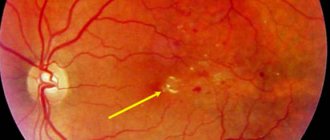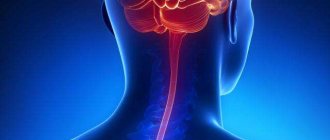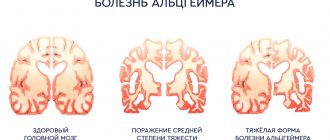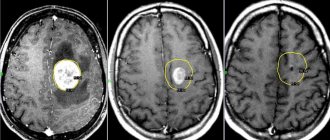What causes vitamin D deficiency?
Vitamin D deficiency in many Russian residents is due to:
- location in the northern temperate zone (above 42 degrees north latitude)
- limited exposure to the sun (office work, driving cars)
- eating meat from animals that have not been exposed to the sun (farm)
- use of sunscreens
- chronic diseases (obesity, intestinal pathology, taking a large number of medications)
You can determine the level of vitamin D in your body by taking the following test:
25-OH vitamin D (25-hydroxycalciferol) (amount)
Multiple sclerosis
Vera Vyacheslavovna Pshenichnikova, neurologist, candidate of medical sciences, head of the department of neurologists for patients with stroke, talks about what everyone needs to know in order not to miss the first signs of this serious disease.
Multiple sclerosis - what kind of disease?
This is a neurological disease, which is based on an inflammatory process in the central nervous system - in the brain and spinal cord. Most nerve fibers are covered with a sheath - a special substance called myelin. In multiple sclerosis (MS), myelin is destroyed, followed by the formation of connective tissue (hence “sclerosis”). And the term “scattered” means the extent of the lesion.
Inflammation occurs in different parts of the brain at different times and causes a variety of symptoms. At the onset of the disease, sensory disorders and a feeling of weakness may occur. Patients are sometimes observed for several years with diagnoses of osteochondrosis, vegetative dystonia syndrome, and asthenic-depressive syndrome. Subsequently, most patients develop a symptom complex that includes: impaired vision and eye movement; paresthesia, impaired coordination of movements, functions of the genitourinary organs and intestines, more about this below.
What are the reasons for the development of the disease? What are the risk factors?
The cause of the disease is still unknown to us, but the central link is dysregulation in the immune system. The immune system, through a tragic mistake, acting against its own body (autoimmune process) destroys the myelin sheath of nerve fibers in the brain and spinal cord. As a result, various body systems stop receiving signals from the brain and symptoms of the disease appear. There are many reasons that negatively affect the immune system. Therefore, MS is called a multifactorial disease.
Geoepidemiological factors determine the high prevalence of MS among people from Northern Europe; There is a latitude gradient - in zones with higher latitudes (distant from the equator) the incidence is higher. Interestingly, Asians practically do not get MS. Quite popular, especially among American scientists, is the version associated with a violation of the intestinal microbiota. There is a proven connection between vitamin D levels and the prevalence of MS. It is assumed that women who have a significant deficiency of this vitamin during pregnancy have a significantly higher risk of giving birth to a child who subsequently develops MS. Also, in people infected with the Epstein-Barr virus and who have had infectious mononucleosis, the risk of developing MS doubles. Oddly enough, smoking is a risk factor for MS. The incidence of this disease among smokers is higher than among those who have never smoked. But perhaps smoking is a marker of a certain psychotype, and not the cause of the disease.
MS is a disease of the young, although in the last ten years the boundaries have been shifting towards both childhood and the elderly. The peak incidence occurs during the most active period of a person’s life—20–40 years. Typically, the later MS begins, the more severe it is. Women get sick about three times more often than men. The disease is extremely rarely inherited, since MS is not believed to be associated with any specific gene.
When should you be wary?
Exactly how MS manifests depends on the location and extent of damage to the nerve fibers. Symptoms of MS are nonspecific and can lie in the area of neurology, ophthalmology, vertebrology and psychiatry. The disease can be suspected by a combination of the following symptoms:
- Visual disturbances (blurred vision, changes in color perception, double vision) most often occur in one eye, but can affect both eyes.
- Increased fatigue, tiredness. These are one of the most common manifestations of multiple sclerosis, which can occur against the background of physical activity, or can be felt constantly, making it difficult to perform even the lightest work.
- Changes in sensitivity: numbness, burning, tingling, itching, changes in temperature sensitivity in different parts of the body. A variation of this type of disorder is Lhermitte’s syndrome, a sensation of “electric current” passing when the head is tilted.
- Pain in the eye when moving the eyeball.
- Muscle weakness, increased muscle tone of the limbs (increased muscle tension).
- Impaired coordination of movements, expressed in loss of balance, instability when walking, trembling of the limbs.
- Bladder problems: frequent urge to urinate, urinary incontinence, or urinary retention.
- Bowel problems - constipation or fecal incontinence.
- Sexual problems
How not to miss a disease?
It is quite difficult to diagnose the disease in time. First, the symptoms are usually mild and go away quickly. And in our busy life there is no time to do things that do not limit us. And even if the patient reaches the doctor, he receives a diagnosis of depression, asthenia, osteochondrosis. Although in a number of cases, patients themselves ignore the first symptoms: they do not notice that they cannot walk normally, that “the legs become heavy,” “the vision blurs.” We need to listen to ourselves.
SO: if these symptoms appear periodically and spontaneously stop, if they are provoked by physical or emotional stress, occur in a hot climate or after taking a hot bath, you must consult a neurologist and undergo a full neurological examination.
Are there any difficulties in diagnosing the disease?
MS is a chameleon disease. It is easy to diagnose when there are visual impairments or movement disorders. But in most cases, diagnosis takes many years. Patients are referred to a specialist after a dozen transient exacerbations and are observed for years by psychiatrists and psychotherapists until the disease progresses to obvious symptoms. Neurological symptoms caused by inflammation and demyelination in the central nervous system, in combination with MRI findings at different periods of time, to the exclusion of all other possible diagnoses, lead to a diagnosis of definite multiple sclerosis. It should be noted that in recent years, due to the availability of MRI, the diagnosis is made earlier.
Where to go for help?
In Moscow, routing is as follows. The patient consults a neurologist and receives a referral to the Interdistrict Multiple Sclerosis Department (IDMS). There are five such branches, each assigned to several districts of Moscow. To speed up the time of getting to a specialist to confirm the diagnosis, it is advisable to do an MRI of the brain and cervical spinal cord in advance.
What treatment approaches are there? What are the forecasts?
Treatment is divided into three main blocks: treatment of exacerbations, treatment that inhibits or changes the course of MS, as well as symptomatic treatment (pelvic dysfunction, spasticity, etc.). In case of exacerbation, immunoglobulin, hormonal drugs, and plasmapheresis sessions are used. Multiple Sclerosis Modifying Drugs (MSMDs) are specific, expensive treatments that are prescribed only at MSDS at the site of attachment. The prognosis of the disease depends on the duration and form of the disease, the response to the treatment, and, of course, adherence to the correct lifestyle (you should avoid prolonged exposure to the sun, visit the bathhouse, sauna). Most people with MS can live a full life with timely and appropriate treatment.
For the curious
Vitamin D
combines a group of vitamins (D1, D2, D3, D4, D5), of which only two forms (D2 and D3) have important biological significance.
| 1. | 7DHC (cholesterol) | A precursor to vitamin D, it forms its reserve in the skin. |
| 2. | D3 (cholecalciferol) | In the skin 80% of vitamin D3 is formed from cholesterol under the influence of beta-UV rays. Its 20% enters the body with food of animal origin (fish oil, liver, egg yolk). |
| 3. | D2 (ergocalciferol) | Enters the body only with plant products (bread, etc.) |
| 4. | 25(OH)D3 (calcidol) | Then in the liver from both forms, as a result of hydroxylation (addition of an OH group), 25-OH-hydroxy-cholecalciferol (calcidol). This form is depot and transport; it is this form that is determined in the blood to determine the level of vitamin D. |
| 5. | 1.25(OH)D3 (calcitriol) | Next in the kidneys with the participation of parathyroid hormone (parathyroid hormone), the second hydroxylation occurs and the formation of the active form - 1,25-OH-dihydroxy-CHOLECALCIFEROL (calcitriol). It is calcitriol that provides the main biological effects of vitamin D in the body. |
The main biological role of calcitriol
(1,25-OH-vitamin D) is to maintain a constant level of calcium in the blood (vitamin D enhances the absorption of calcium in the intestines and, if there is not enough calcium in the blood, ensures the flow of calcium from the bones into the blood).
Over time, receptors for calcitriol, in addition to the intestines and bones, were found in the kidneys, genitals, pancreas, muscles, cells of the immune and nervous systems. Thus, it became clear that vitamin D performs a large number of different functions in the human body:
- regulates the expression of 3% of the human genome (several thousand genes)
- increases the sensitivity of the insulin receptor (prevention of insulin resistance, obesity, diabetes)
- strengthens the skeletal system
- reduces the level of parathyroid hormone in the blood
- promotes the synthesis of sex hormones (testosterone, estrogens, progesterone)
- improves reproductive function
- affects innate and acquired immunity
- prevents the development of tumors, depression, Parkinson's disease
Vitamin D and autoimmune aggression
Autoimmune diseases are associated with pathology of the immune system, when some of the body's own cells are perceived as foreign, and an immune response develops to them with the development of inflammation. The role of vitamin D in the development of such a pathological immune response differs from the role of vitamin D in the normal functioning of the immune system.
With an autoimmune disease, the production of T-lymphocytes (T-cells of the immune system) increases, which recognize one of the types of body cells as foreign, starting a “fight” with them. However, excess T cell activation regulated by vitamin D does not occur. Thus, due to regulation by vitamin D, the number of activated killer T cells (killer cells) does not increase significantly, despite the large number of circulating inactive T cells of the immune system.
In addition, with the development of an autoimmune disease, the production of pro-inflammatory cytokines, proteins responsible for the development of the inflammatory response, significantly increases. Scientific studies have shown that vitamin D reduces the formation of “inflammatory proteins” (pro-inflammatory cytokines). These include interleukin-1, interleukin-6, interleukin-8, tumor necrosis factor alpha; to a lesser extent, vitamin D affects interferon gamma, interleukin-17 and interleukin-21.
Thus, the important role of vitamins D in the regulation of the body’s immune function in the treatment of autoimmune diseases such as rheumatoid arthritis, multiple sclerosis, Crohn’s disease, systemic lupus erythematosus, and many other autoimmune conditions has been shown.
A similar positive effect of vitamin D on inhibiting the development of an excessive immune response is also shown in the case of donor organ transplantation. Immune rejection of transplanted tissue or organ develops by a mechanism similar to an autoimmune reaction. In this connection, a sufficient level of vitamin D in the blood has a positive regulatory effect on the body’s immune response during donor organ transplantation.
Vitamin D deficiency
A lack of vitamin D in the body can lead to the development of:
- diseases of the cardiovascular system
- immunodeficiency, allergies, psoriasis, bronchial asthma, rheumatoid arthritis
- periodontal disease
- tumors of the large intestine, mammary glands, ovaries, prostate
- chronic fatigue, depression, insomnia
- decreased muscle strength leading to a risk of falls
- decreased motility and number of morphologically normal sperm (male factor infertility)
- risk factor for premature birth, fetopathies (less than 20 ng/ml)
Achieving a vitamin D level of 50 ng/ml (125 nmol/l) reduces the risk of developing:
| % | |
| Rakhita | 100 |
| Ostemalacia (softening of bone tissue) | 100 |
| Cancer in general | 75 |
| Breast cancer | 50 |
| Ovarian cancer | 25 |
| Colon cancer | 65 |
| Kidney cancer | 65 |
| Uterine cancer | 35 |
| Diabetes mellitus type 2 | 50 |
| Perelomov | 50 |
| Falls in women | 70 |
| Multiple sclerosis | 50 |
| Myocardial infarction | 50 |
| Vascular diseases | 80 |
| Preeclampsia | 50 |
| Caesarean section | 75 |
| Infertility | 70 |
Vitamin D is important during pregnancy.
Its deficiency is associated with the risk of developing gestational diabetes mellitus, premature birth, preeclampsia, and various intrauterine developmental defects.
There is not a single case of teratogenic (leading to the development of tumors) effect of vitamin D in the world.
Prevention
For the purpose of prevention, the officially recommended dose of vitamin D is taken, which is 800 units. 1-2 times a week. This amount is sufficient to maintain normal phosphorus-calcium metabolism. The safe dose for prevention is 2000 units; such a dose can be prescribed by a specialist if there are certain indications.
Attention!
For medical indications, a therapeutic dose is indicated, which is also determined by the attending physician. Such doses are prescribed for patients with diabetes mellitus, cancer, obesity, atherosclerosis, and also in the presence of a pronounced inflammatory process in the body.
The medical literature contains data on the improvement of the condition of cancer patients and the recovery of patients with significantly reduced immunity who took high doses of vitamin D (up to 5000 IU). In any case, the therapeutic dosage is determined only by a specialist.
The doctor recommends a therapeutic dosage and number of doses based on test results (vitamin D and calcium levels are determined). Patients with gastritis, peptic ulcers, or kidney stones are prohibited from taking the drug without a doctor's prescription. In addition, with frequent bone fractures and early diagnosed osteoporosis (patient age under 45-50 years), taking any vitamins and minerals without consulting a doctor is also prohibited.
Vitamin D standards
Considering the different units of measurement, the recommended level is:
60 - 100 ng/ml
150 – 250 nmol/l
To convert from ng/ml to nmol/l you need ng/ml * 2.5 = nmol/l
Example: 30 ng/ml * 2.5 = 75 nmol/l
Russian Association of Endocrinologists
considers
the optimal concentration
of vitamin D in the blood of an adult to be 30-100 ng/ml,
deficiency is
20-30 ng/ml,
deficiency
is less than 20 ng/ml.
According to data presented at the 10th European Congress on Menopause and Andropause (Madrid, 2015), vitamin D levels in obese patients in Russia:
less than 20 ng/ml - 35%
20-30 ng/ml - 30%
more than 30 ng/ml - 35%
Daily Values for Vitamin D
according to the recommendation of the American Society of Endocrinology (2011).
| Age group | Recommended daily dose, IU | Maximum permissible level of consumption, IU |
| Infant, 0 - 6 months | 400 | 1000 |
| Infant, 7 - 12 months | 400 | 1500 |
| Children 1 - 3 years old | 600 | 2500 |
| Children 4 - 8 years old | 600 | 3000 |
| Children 9 - 17 years old | 600 | 4000 |
| Adults 18 – 70 years old | 600 | 4000 |
| Adults over 70 years old | 800 | 4000 |
| Pregnancy and lactation | 800 | 4000 |
Prophylactic dose
vitamin D (when you can not detect it in the blood and take it calmly) is considered to be 4,000 IU per day.
Without medical supervision, it is not recommended to take vitamin D at a dose of 10,000 IU for more than 6 months. (Russian Association of Endocrinologists)
It is almost impossible to overdose on vitamin D. For example, in Holland, an elderly couple (90 and 95 years old) accidentally took a single dose of cholecalciferol 2,000,000 IU each.
Doctors monitored them for 2 months and did not identify any symptoms of overdose or toxicity. The maximum blood concentration of its form of 25-OH-vitamin D on day 8 was 210 and 170 ng/ml, respectively, which is slightly higher than its target values.
Risks of Taking Vitamin D
Too much vitamin D (> 100 ng/ml) is no less dangerous than too little vitamin D. Because vitamin D enhances the absorption of calcium, this results in hypercalcemia—too much calcium in the body. The list of consequences is long - from weakened bones and kidney problems to heart and brain problems. Since excess calcium is deposited in the skeleton, arteries, and soft tissues.
An “overdose” of vitamin D occurs precisely because of supplements. It is impossible to get too much of a dose in the sun, because the body itself automatically limits the amount of vitamin produced. From food - also unlikely: for a potentially unsafe dose of 4000 IU, you need to eat more than a kilogram of trout per day. And it’s not a fact that the body will absorb all the vitamin D from fish. But it’s easy to overdo it with additives. To prevent this from happening, follow the following safety rules.
- Take high doses of vitamin D only for treatment.
Not preventive, but therapeutic doses of the vitamin (on average more than 800 IU per day for an adult) can be taken only after testing for vitamin D and calcium in the blood and prescription by a doctor. - Follow the dosage.
The one prescribed by the doctor (in the case of therapeutic doses) or medical organizations (in the case of preventive doses, usually indicated by the manufacturer on the packaging). - Get tested.
When taking vitamin D above the preventive dose, monitor not only your blood vitamin D levels, but also your calcium levels. The doctor will definitely prescribe this in the prescription; the main thing is not to ignore the recommendation and not try to save money. - Don't take multiple vitamin D products at once.
A common mistake is when people take vitamin D supplements and multivitamins that also contain vitamin D at the same time. - Do not take combination medications for prevention.
Supplements such as Calcium-D3 increase levels of both calcium and vitamin D. This increases the risks of hypercalcemia. They should be prescribed by a doctor - and only after analyzing calcium levels.
- Do not take calcitriol unless prescribed
. This is the active form of vitamin D, which is formed in the kidneys when D2 or D3 is metabolized. It is not safe to take calcitriol off-label because it increases vitamin D levels too much. It is usually prescribed for conditions such as kidney failure.
Compound
| Ingredient name | Amount per 1 dose (0.5 ml) | % RUSP |
| Vitamin D3 (cholecalciferol in liposomal form), mcg/IU | 10 / 400 | 200% |
Auxiliary components: purified water, xylitol, lecithin, glycerin, potassium sorbate, natural apricot flavor, alpha-tocopherol.
Contains sweetener. If consumed in excess, it may have a laxative effect.
May contain traces of soy and sesame.
Comparison with low dose vitamin D
High-dose vitamin D, in contrast to low doses of the drug, has a number of significant therapeutic benefits. This:
- The speed of onset of the therapeutic effect. A large dosage of the drug contributes to the rapid normalization of metabolic processes, which significantly affects the state of human health.
- Shorter duration of treatment. Due to the fact that a large concentration of vitamin D enters the body in one dose of the drug, a person will not need to undergo a long course of treatment.
- Safety. Numerous studies have shown that high-dose vitamin D therapy has no harmful effects on health.










